How to make the perfect paella: Guillermo Navarro says you're doing wrong - here's why
Navarro set up the website Wikipaella.org after eating in an apparently traditional Valencian restaurant that served a 'horrible' version of the dish. He has now made it his mission to show what a real paella should be
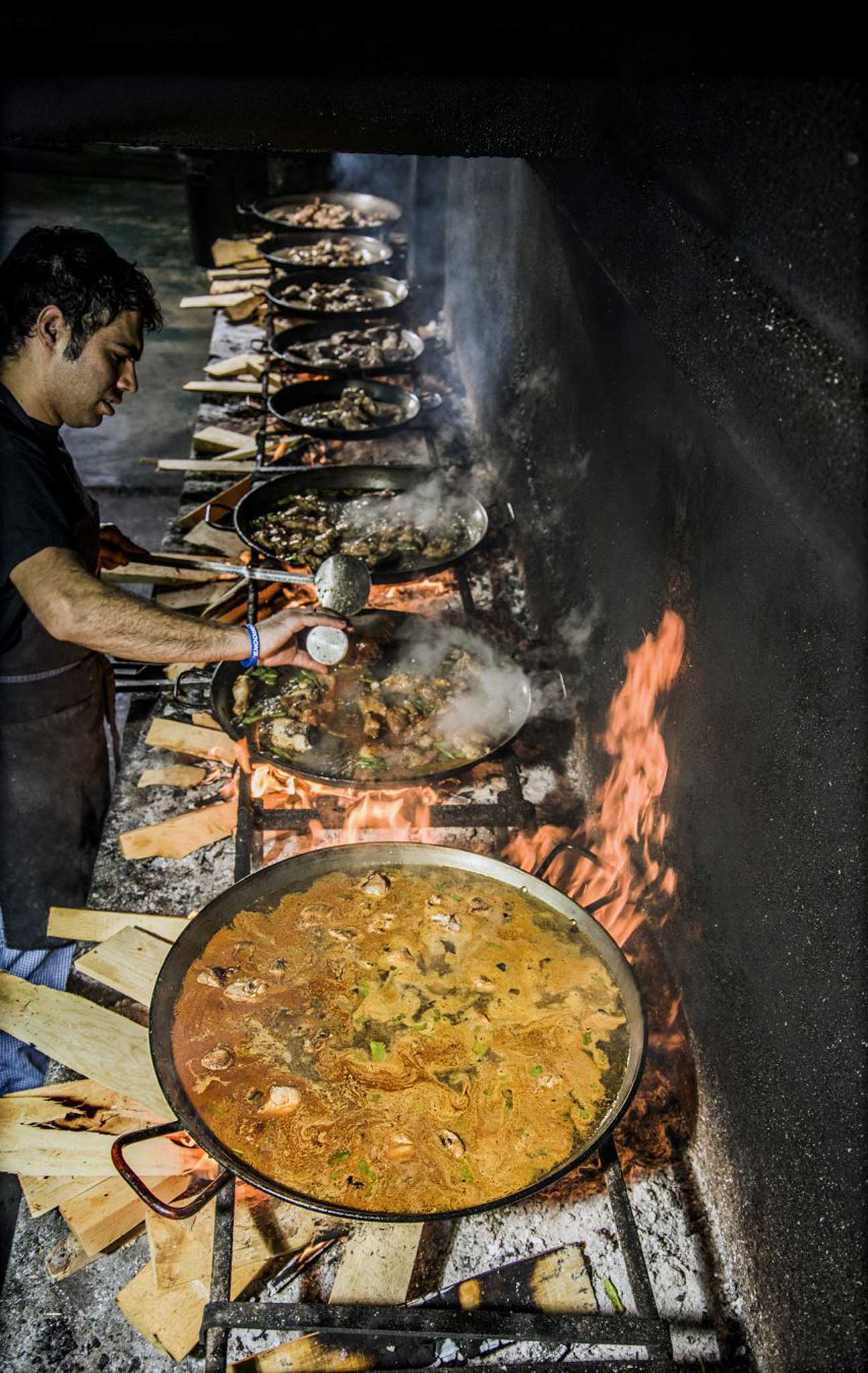
Your support helps us to tell the story
From reproductive rights to climate change to Big Tech, The Independent is on the ground when the story is developing. Whether it's investigating the financials of Elon Musk's pro-Trump PAC or producing our latest documentary, 'The A Word', which shines a light on the American women fighting for reproductive rights, we know how important it is to parse out the facts from the messaging.
At such a critical moment in US history, we need reporters on the ground. Your donation allows us to keep sending journalists to speak to both sides of the story.
The Independent is trusted by Americans across the entire political spectrum. And unlike many other quality news outlets, we choose not to lock Americans out of our reporting and analysis with paywalls. We believe quality journalism should be available to everyone, paid for by those who can afford it.
Your support makes all the difference.It's something of a mid-week staple round at my place. Easier than risotto, and with no need for all that stock-stirring nonsense. Just fry up a bit of onion and garlic, add a few chunks of chorizo, chuck in some chicken, or prawns, or both, and some short-grain rice – Spanish if you've got it, or whatever else comes to hand. Then cover with stock and a bit of saffron (optional), and 20 minutes or so later, you've got a lovely paella.
Only you haven't. According to the traditionalists, my slipshod approximation of Valencia's famous regional dish is an abomination, and exactly the kind of thing that a brave band of paella preservationists is up in arms about. Horrified by the dismal bastardisations of their local speciality which are passing for the real thing, they're campaigning to tell the world about the true Valencian paella.
Have a look at their website, Wikipaella.org, and you'll see that these paell-activists can get surprisingly heated on the subject. There's a 10-point manifesto, which moves from the stern, 'We publicly condemn infringements made against authentic paella, especially within the community of Valencia/Spain' to the emotional, 'We carry the paella in our hearts and we travel with it as far as possible'.
There's a map, too, which identifies the umpteen local varieties of paella in the Valencia region of Spain's Mediterranean coast. The ingredients vary from village to village and season by season. But one thing is clear: none of them contains chorizo.
To atone for my sins, I've made the pilgrimage to the birthplace of paella, Valencia, to seek enlightenment from one of Wikipaella's founders, Guillermo Navarro. Over a couple of days spent in and around the city, I will discover what I, Jamie Oliver and the rest of the paella-traducing world have been doing wrong. Which, it seems, is pretty much everything. The one rule about paella club, as I will learn, is that there are a LOT of rules about paella.
I'd barely touched down in Valencia when my paell-education began. Guillermo is waiting for me armed with an itinerary and an apostolic gleam in his eye. A neatly-bearded ad man in his mid-thirties, he returned to his native Valencia after working in New York, and was struck by how many dodgy versions of his beloved local dish were being peddled around the city and in the rest of Spain.
Wikipaella was born after a friend took him out to eat in Madrid, in an apparently traditional restaurant decorated with Valencian flags. "Normally, we Valencians don't eat paella outside our city, but they were selling it as traditional. The paella was just horrible. The rice was awful – Chinese rice flavoured with a stock cube. It contained peas, carrots, mushrooms. NO! Those things don't belong in paella. And the place was full of tourists – Japanese, Americans – who'd come to Spain looking for traditional paella. It was such a bad experience, I decided I needed to do something to show what a real paella should be."
Now he's going to do exactly that for me. As we talk through Guillermo's itinerary, it's clear that, were I to follow it to the letter, I'd be eating four or five paellas a day over a two-day period. Thankfully, true Valencians never eat paella at night – that's really the mark of a rube, like drinking a cappuccino after lunch in Rome.
So after intense negotiations, we hone my research trip down to two paella-based lunches. On day one, we'll stay in the city, to sample an authentic seafood paella at a beachside restaurant. And on day two, Guillermo will take me and my 13-year-old son deep into paella country, to try what he believes to be a truly authentic version of the dish, cooked over wood fires as it has been for more than a century.
Paco Alonso and Guillermo Navarro, the founders of Wikipaella, sailing in Palmar (Xavier Cervera/Panos Pictures)
Paella 1: Casa Ripoll
We're allowed to branch off on our own for Paella One. Valencia, like its better-known northerly cousin Barcelona, is a wonderful city to walk around, the centre a maze of twisty streets and alleys. On every corner there's another come-hither tapas bar or a horchateria offering the local speciality, a creamy sweetened drink made with tiger nuts. It would be easy to lose yourself for a weekend here, but there's another attraction on the edge of town – miles of pristine Mediterranean beaches, lined with restaurants and cafés.
A short bus ride from our hotel and we're sitting in a restaurant on Malvarossa beach, me with a glass of apricot Valencian wine in hand. Our walk here has taken us past umpteen deserted off-season restaurants, all of them offering versions of paella and other local dishes such as arroz negro. It's clear why the Wikipaellans are concerned. How does a novice identify the ones which are doing it properly, rather than popping something into the microwave?
Casa Ripoll (casaripoll.com) is one of 170 restaurants in the area that have earned the Wikipaella seal of approval, and can proudly display their accreditation. From the eight varieties of paella on offer, including rabbit and duck, monkfish and clams, and lobster, we choose their speciality, paella marinera. Following true Valencian tradition, it contains only local seafood; strictly no meat or vegetables. There is, however, a 'mixta' version with chicken and seafood lurking at the bottom of the list, presumably for tourists.

While our paella is cooked to order, we feast on squid fried with wild garlic, airy salt-cod fritters, and a grilled red pepper salad with cured tuna loin, slightly taking the edge off our appetites. Then it's paella time. It arrives at the table in the pan (also called a paella) and our waiter offers to serve us, but he won't catch us out like that. We will eat it the Valencian way, directly from the paella, though we do use cutlery, rather than the tradition wooden spoon.
Dark brownish-orange in colour, and jewelled with plump pink prawns and amber tangles of squid, this looks nothing like the pallid sludge I served my son earlier in the week. What's striking is how thinly the rice is spread; no more than a shiny, sticky grain thick. Stirring is strictly forbidden during the cooking process, so the rice sticks to the pan, and is toasted to a crunch round the edges. But far from drying out, it has a satisfying, al dente bounce, each grain completely distinct. Dark, intense and very, very salty, it's totally addictive, and we end up chipping away at the black, crusty bits which cling to the bottom of the pan.
It soon becomes clear why paella is a lunchtime dish. Abandoning our plans to visit Valencia's futuristic aquarium and science museum, we have no option but to take a recovery siesta, in preparation for the next day's round of Gringo vs Paella.
Arroceria 'las Bairetas' is a family-run business where they do things the old-fashioned way (Xavier Cervera/Panos Pictures)
Paella 2: Arroceria 'las Bairetas'
Like true Valencians, we shun breakfast in favour of almuerzo, the mid-morning snack, which we take al fresco in the Jardin del Turia, the sunken park which runs through the centre of the city. Created from the river bed when the Rio Turia was diverted to prevent flooding, this 11-kilometre expanse of beautifully landscaped gardens, spanned by ancient bridges, stretches all the way to the ocean.
No time to explore, though; we're on a paella mission. We head to the Central Market, a beautiful Art Deco cathedral of vaulted stained glass, surrounded by ferreterias selling paella pans. Inside, it's a warren of swinging hams, meticulously aligned seafood and camera-ready fruit apparently arranged by the world's greatest food stylist.
Thinking ahead to my next home-made paella, I buy local saffron from a stall whose owner is keen to show me a certificate of purity, and sacks of bomba rice, the most prized of the local varieties. Bent double under his backpack, my son pleads with me not buy a paella pan the size of a satellite dish. A flagrant breach, in my view, of article 10 of the Wikipaella manifesto: 'We carry the paella in our hearts and we travel with it as far as possible'.
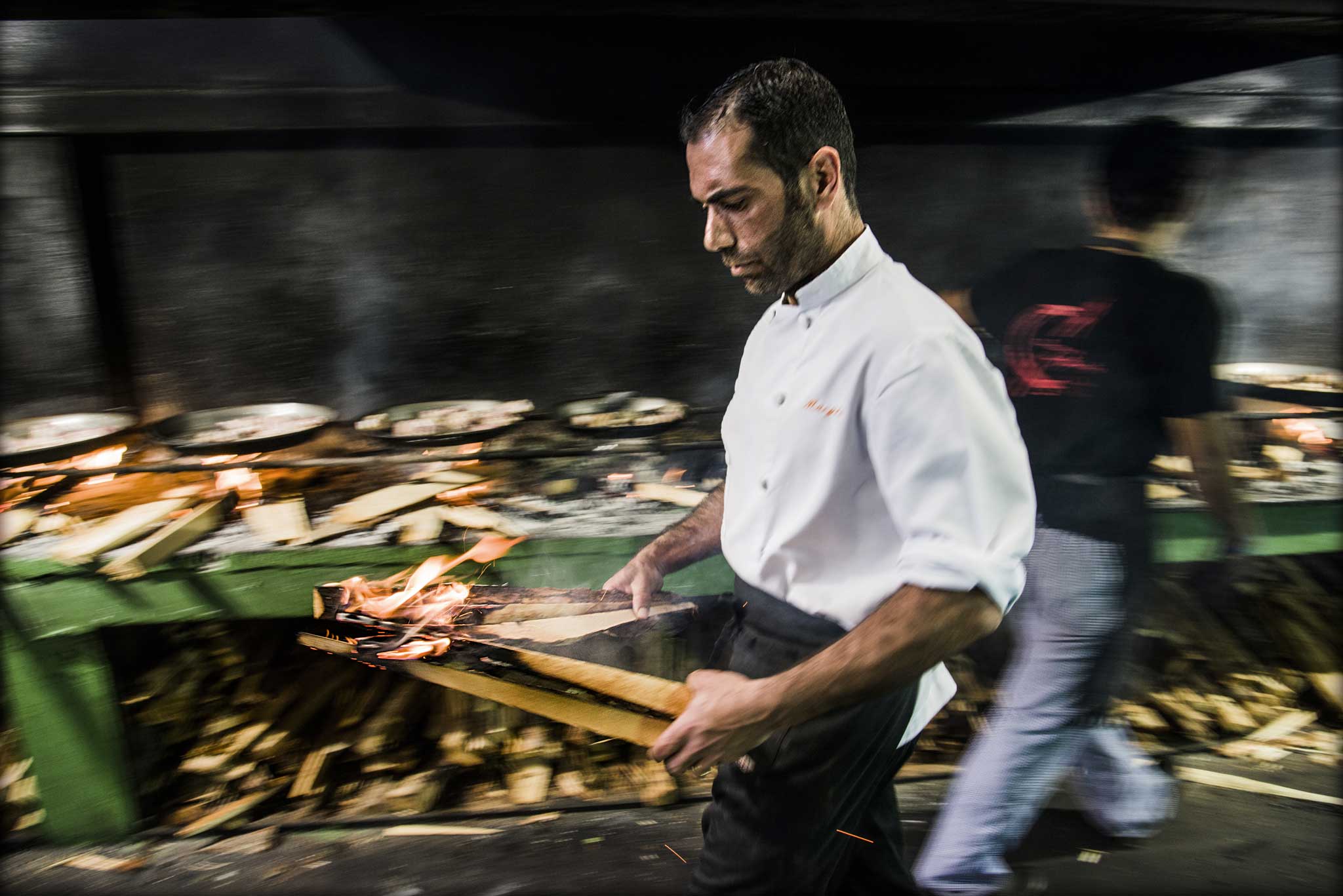
That afternoon's expedition with Guillermo takes us 20kms inland, to the small town of Chiva. It's way off the tourist trail, but Guillermo is effusive about the local restaurant, Arroceria 'las Bairetas' (lasbairetas.com), a family-run business where they do things the old-fashioned way. Even in the paella heartland, the most authentic restaurants have long since switched to gas. But here, the four Margós brothers still cook their paellas over wood, using only local ingredients.
I'm expecting a picturesque village, but Chiva is a small working town. Las Bairetas sits in an unprepossessing strip of light-industrial buildings, sandwiched between the main road and a railway track. Proudly indicating the Wikipaella sticker on the door, Guillermo leads us into a minimal all-white dining room, its tables crisply naped, which is the very opposite of rustic. In the gleaming kitchen, a young chef is drizzling sauces from squeezy bottles on to intricately-worked desserts. Can this really be the home of Valencia's most authentic paella?
But behind the kitchen there's the paella kitchen, a medieval furnace lined with wood-burning fires, each with a pan bubbling away over it. A sweating chef tends each paella, one adding salt, another tossing in a branch of rosemary, a third weighing out rice on an ancient set of scales.
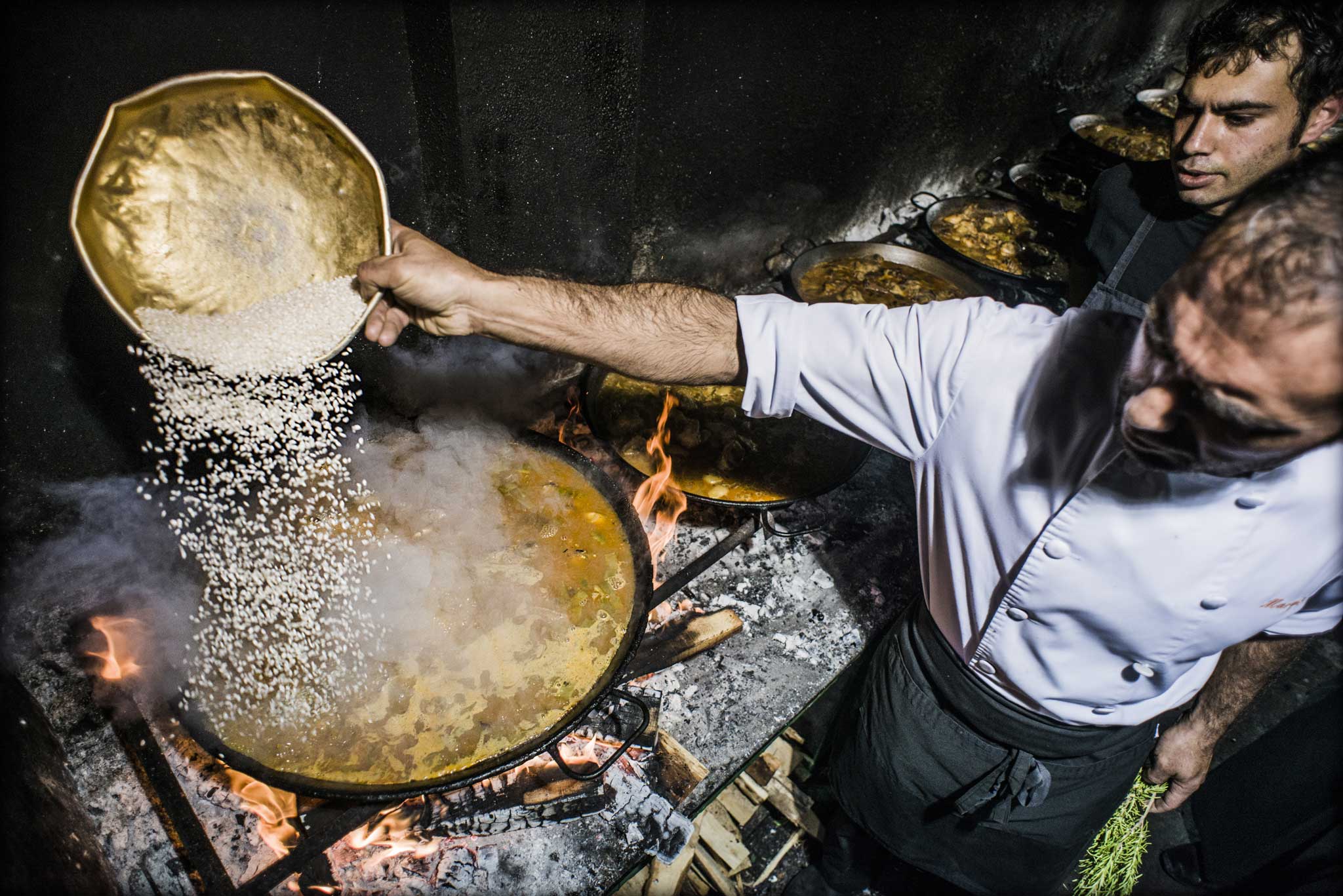
Boss Rafa, the oldest of the four Margós brothers who work here, talks me through the two-hour process which goes into each paella. Key to the whole thing is the rice; here they use senia, starchier, but harder to cook than the more usually prized bomba (which I've invested so heavily in). Most of the paellas simmering away are the classic summer variety, containing rabbit and chicken, Valencian tomatoes, flat green ferradura beans and lima beans, but a couple of well-padded workmen drop by to collect a duck and mushroom version they've ordered, taking it away in the pan. Mercifully, snails, the other traditional ingredient, are out of season.
We escape the broiling kitchen, which can reach 60 degrees when all 143 paellas are fired up at once, for the cool, white-tiled restaurant. When the paella arrives, it's notably dry, but swoony and rich, with a breath of smoke and rosemary running through it. Each grain of rice has bite, and the rabbit is sweet, though the bony nuggets present a challenge to the younger diner. Best of all is the umami crunch of the socarrat, the black crust that sticks to the bottom of the pan. "Valencian caviar," Guillermo smiles proudly.
Our paella pilgrimage ends with a visit to the true heart of paella country, the village of El Palmar, by the coast on Lake Albufera. It's this weird, watery landscape of palm trees, orange groves and rice fields which spawned the earliest paella-eaters, rice-cultivating fishermen who would go out in their flat-bottomed boats to tend their crops, lifting their eel nets along the way. Now Palmar is a magnet for city folk and tourists, its two small streets lined with 36 restaurants, all serving more or less the same dishes.
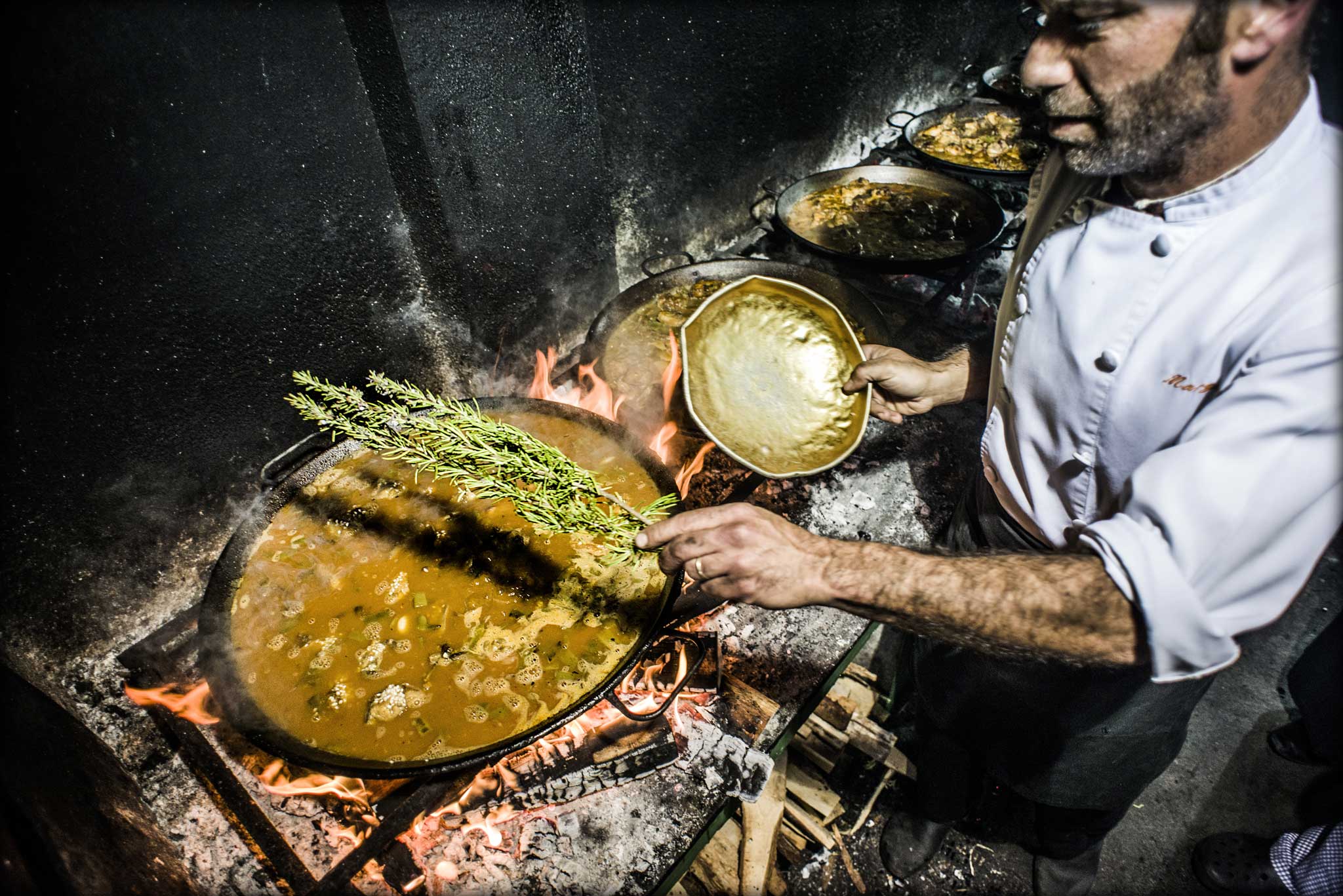
On Sunday lunchtimes, when paella is traditionally eaten, the place is mobbed, with up to 5,000 Valencians and tourists descending. But on a mid-week afternoon, it's deserted. Waiting on a jetty by the lake is a smartly-dressed media gent – Paco Alonso, the other driving force behind Wikipaella. He has set up a surprise for us, a trip round the lake aboard a 150-year-old Latin-sailed punt, captained by Victor, a fourth-generation Palmar fisherman.
As we pootle around between the paddy fields, the smell of orange blossom drifting over the still water, I'm amazed to see the cranes and tower blocks of industrial Valencia rising in the distance, so unchanging does the landscape feel. Paco, an author and food personality with his own show on TVE, tells us about the origins of paella, which dates back only to the mid-19th century, with the rise of the metal industry.
As he and Guillermo talk, I'm struck by the shared passion which has brought these two urbane, well-travelled Spaniards together, to leave their offices for the afternoon and drift around on a boat, enthusing about paella. What's clear is that it's not just a food thing. For the Wikipaella founders, the campaign is political, driven by fierce local pride. They're pushing for official backing to turn the campaign into a not-for-profit foundation.
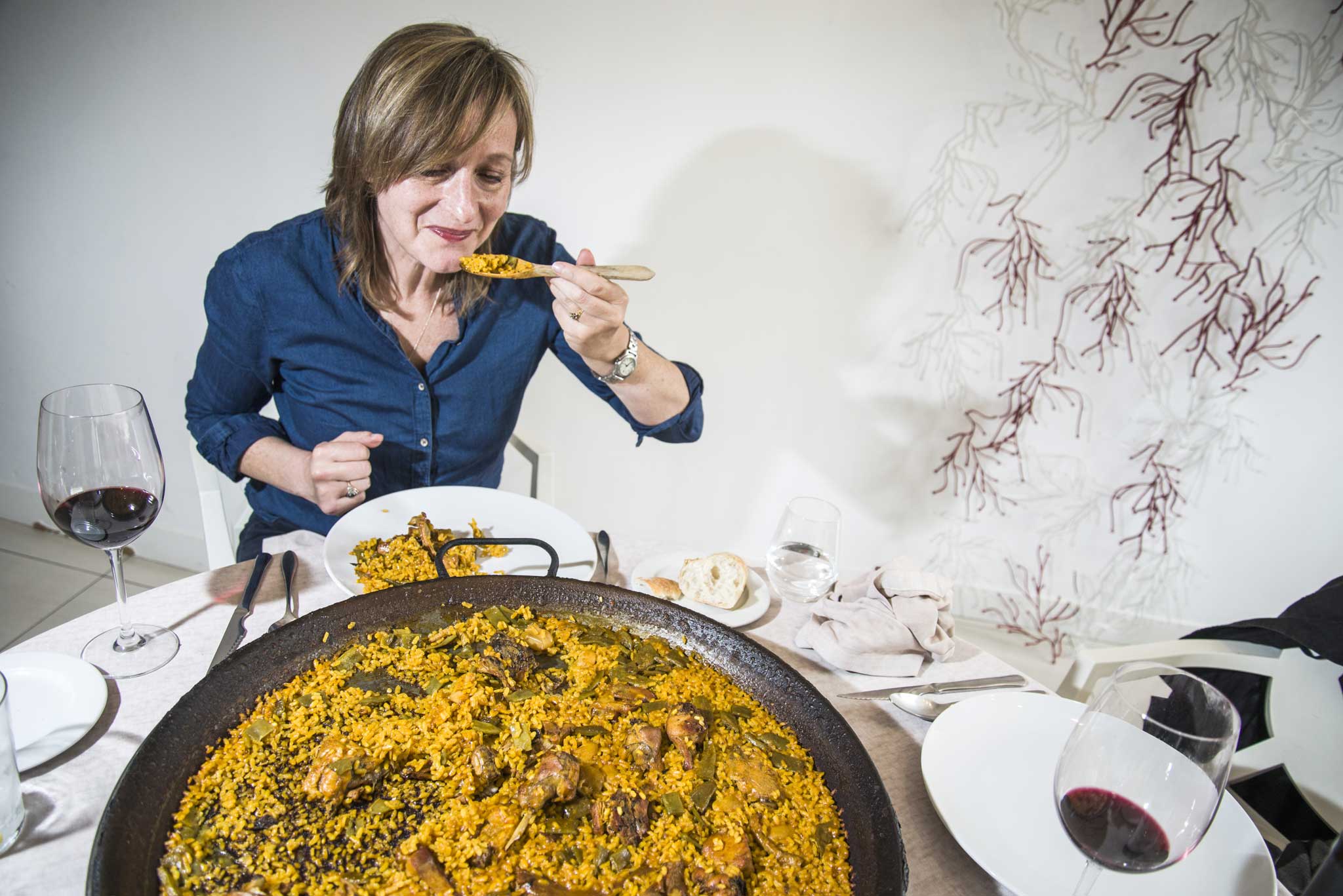
"Valencia doesn't have the same confidence as Catalunya," Guillermo tells me. "Our food culture is as vibrant as theirs. We should be promoting our food, paella, and our drink, horchata. It's not just about food. It's about tradition, community, unity."
I know the Wikipaella message has taken root when, on the way home, I spot a dismal, fluorescent paella, topped with fraying chicken and curling squid, coagulating under a heat lamp in the airport café. To the confusion of the queue, I snap a paellfie in front of it, to add to the Wikipaella hall of shame.
Having tasted the real thing, I can't imagine being tempted to eat this solidifying facsimile. Mind you, now that I know all the rules, I don't think I'll ever be able to cook a paella at home again.
Tracey MacLeod travelled with Kirker Holidays. A three-night stay at the Westin Valencia costs from £534 pp (two sharing), including accommodation with breakfast, return private transfers, entrance to the City of Arts and Sciences, and Kirker's guide notes. Call Kirker Holidays on 020-7593 2283, kirkerholidays.com
Recipe from Arroceria 'Las Bairetas'
Serves 4
60ml olive oil
20g salt
150g chicken legs and thighs
150g rabbit legs and ribs
120g green beans
40g striped tomatoes
60g lima beans (garrofó), frozen or fresh and boiled
5g smoked paprika
2ltrs water
1g saffron
1 branch of fresh rosemary
420g Valencian rice (bomba or senia)
1. Put the oil and salt in the paella pan and fry the chicken and rabbit on medium heat for approx 20 minutes.
2. Add the green beans and tomatoes (cut into finger-sized pieces), and cook for 5 minutes; then add the paprika and fill the pan almost to reach the iron nails. When it comes to the boil, add the garrofó.
3. Cook until all the water has gone, then reduce the heat and add more water, again almost up to the iron nails.
4. Taste the broth, add more salt if needed, add the saffron and turn the heat high.
5. Add the rice and the fresh rosemary for just 3 minutes and then remove it.
6. Cook over a high heat for 10 minutes, then turn down the heat slowly and cook for a further 20 minutes, until the water is no longer evident.
7. Leave the paella to stand for 5 minutes then eat straight from the pan.
The 10 Golden Rules of Authentic Valencian Paella
1. Don't mix seafood and meat. And only use seafood if by the sea.
2. True Valencian paella is made with rabbit, chicken and green beans in the summer, duck and artichoke in the winter.
3. No garlic. No peas. No potatoes. No stock. NO CHORIZO.
4. Only use Spanish rice, preferably Valencian bomba or senia.
5. Cook over wood, for that authentic smoky flavour.
6. On no accounts, stir. The rice should stick to the pan.
7. Oh, and that pan should be an authentic paella. Not a frying pan. And definitely not a wok.
8. Eat it straight from the pan, preferably using a wooden spoon. At lunchtime only.
9. If it's served in a portion for one, it isn't the real thing, it's been frozen and reheated. Or it's from Vesta.
10. For ultra-authenticity, it should only be cooked by a man. A Spanish man. In Valencia.
Join our commenting forum
Join thought-provoking conversations, follow other Independent readers and see their replies
Comments